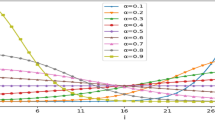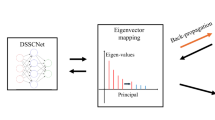Abstract
Multi-view data are usually collected from distinct sources or domains which lead to each view owning both specific physical attributes and shared attributes. How to make better use of the consistency and complementarity of multiple views to improve clustering performance is a challenging problem in multi-view subspace clustering task. In this paper, we propose a novel multi-view subspace clustering method which learns shared and specific latent representations, and corresponding self-representations with local structure preserving by projecting all views to their respective low-dimensional latent spaces, called multi-view subspace clustering via joint latent representations. Related optimization problem is effectively solved utilizing the alternating direction method of multipliers. The consistency and complementary information of multiple views is captured by the learned shared and specific representations, respectively, which strengthens the performance of our proposed approach. Experimental results on real datasets demonstrate the effectiveness of the proposed method.






Similar content being viewed by others
Notes
References
Amini MR, Usunier N, Goutte C (2009) Learning from multiple partially observed views-an application to multilingual text categorization. In: Advances in neural information processing systems, vol 22. pp 28–36
Bartels RH, Stewart GW (1972) Solution of the matrix equation AX+ XB= C. Commun ACM 15(9):820–826
Belkin M, Niyogi P (2001) Laplacian eigenmaps and spectral techniques for embedding and clustering. Adv Neural Inf Process Syst 14:585–591
Boyd S, Parikh N, Chu E, Peleato B, Eckstein J (2010) Distributed optimization and statistical learning via the alternating direction method of multipliers. Mach Learn 3(1):1–122
Brbic M, Kopriva I (2018) Multi-view low-rank sparse subspace clustering. Pattern Recogn 73:247–258
Cao X, Zhang C, Fu H, Liu S, Zhang H (2015) Diversity-induced multi-view subspace clustering. In: Proceedings of the IEEE conference on computer vision and pattern recognition, pp 586–594
Chao G (2019) Discriminative k-means Laplacian clustering. Neural Process Lett 49(1):393–405
Chao G, Sun J, Lu J, Wang AL, Langleben DD, Li CS, Bi J (2019) Multi-view cluster analysis with incomplete data to understand treatment effects. Inf Sci 494:278–293
Chao G, Sun S, Bi J (2021) A survey on multi-view clustering. IEEE Trans Artif Intell. https://doi.org/10.1109/TAI.2021.3065894
Du L, Zhou P, Shi L, Wang H, Fan M, Wang W, Shen YD (2015) Robust multiple kernel k-means using l21-norm. In: Twenty-fourth international joint conference on artificial intelligence, pp 3476–3482
Elhamifar E, Vidal R (2013) Sparse subspace clustering: algorithm, theory, and applications. IEEE Trans Pattern Anal Mach Intell 35(11):2765–2781
Gao H, Nie F, Li X, Huang H (2015) Multi-view subspace clustering. In: Proceedings of the IEEE international conference on computer vision, pp 4238–4246
Hofmann T, Buhmann JM (1998) Active data clustering. Adv Neural Inf Process Syst 10:528–534
Hu H, Lin Z, Feng J, Zhou J (2014) Smooth representation clustering. In: Proceedings of the IEEE conference on computer vision and pattern recognition, pp 3834–3841
Huang J, Nie F, Huang H (2013) Spectral rotation versus k-means in spectral clustering. In: Twenty-seventh AAAI conference on artificial intelligence. Citeseer
Kang Z, Zhou W, Zhao Z, Shao J, Han M, Xu Z (2020) Large-scale multi-view subspace clustering in linear time. In: Proceedings of the AAAI conference on Artificial Intelligence, vol 34. pp 4412–4419
Kumar A, Rai P, Daume H (2011) Co-regularized multi-view spectral clustering. In: Advances in neural information processing systems, pp 1413–1421
Li CG, Vidal R (2015) Structured sparse subspace clustering: a unified optimization framework. In: Proceedings of the IEEE conference on computer vision and pattern recognition, pp 277–286
Li Y, Nie F, Huang H, Huang J (2015) Large-scale multi-view spectral clustering via bipartite graph. In: Proceedings of the twenty-ninth AAAI conference on artificial intelligence, pp 2750–2756
Lin Z, Liu R, Su Z (2011) Linearized alternating direction method with adaptive penalty for low-rank representation. In: Advances in neural information processing systems, pp 612–620
Liu G, Lin Z, Yan S, Sun J, Yu Y, Ma Y (2013) Robust recovery of subspace structures by low-rank representation. IEEE Trans Pattern Anal Mach Intell 35(1):171–184
Liu X, Li M, Tang C, Xia J, Xiong J, Liu L, Kloft M, Zhu E (2020) Efficient and effective regularized incomplete multi-view clustering. IEEE Trans Pattern Anal Mach Intell. https://doi.org/10.1109/TPAMI.2020.2974828
Luo S, Zhang C, Zhang W, Cao X (2018) Consistent and specific multi-view subspace clustering. Proc AAAI Conf Artif Intell 32:3730–3737
Manjunath BS, Ohm JR, Vasudevan VV, Yamada A (2001) Color and texture descriptors. IEEE Trans Circuits Syst Video Technol 11(6):703–715
Ng A, Jordan M, Weiss Y (2001) On spectral clustering: analysis and an algorithm. Adv Neural Inf Process Syst 14:849–856
Robles-Kelly A, Hancock ER (2004) Spanning tree recovery via random walks in a riemannian manifold. In: Iberoamerican congress on pattern recognition. Springer, pp 303–311
Sun S, Xie X, Dong C (2018) Multiview learning with generalized eigenvalue proximal support vector machines. IEEE Trans Cybern 49(2):688–697
Tang W, Lu Z, Dhillon IS (2009) Clustering with multiple graphs. In: 2009 Ninth IEEE international conference on data mining. IEEE, pp 1016–1021
Wang S, Liu X, Zhu E, Tang C, Liu J, Hu J, Xia J, Yin J (2019) Multi-view clustering via late fusion alignment maximization. In: IJCAI, pp 3778–3784
Wang X, Guo X, Lei Z, Zhang C, Li SZ (2017) Exclusivity-consistency regularized multi-view subspace clustering. In: Proceedings of the IEEE conference on computer vision and pattern recognition, pp 923–931
Wen J, Zhang Z, Zhang Z, Fei L, Wang M (2020) Generalized incomplete multiview clustering with flexible locality structure diffusion. IEEE Trans Cybern 51(1):101–114
Wold S, Esbensen K, Geladi P (1987) Principal component analysis. Chemom Intell Lab Syst 2(1–3):37–52
Xia R, Pan Y, Du L, Yin J (2014) Robust multi-view spectral clustering via low-rank and sparse decomposition. In: Proceedings of the AAAI conference on artificial intelligence, vol 28
Xie X (2018) Regularized multi-view least squares twin support vector machines. Appl Intell 48(9):3108–3115
Xie X, Sun S (2019) Multi-view support vector machines with the consensus and complementarity information. IEEE Trans Knowl Data Eng 32(12):2401–2413
Xie X, Sun S (2020) General multi-view semi-supervised least squares support vector machines with multi-manifold regularization. Inf Fusion 62:63–72
Xu J, Han J, Nie F (2016) Discriminatively embedded k-means for multi-view clustering. In: Proceedings of the IEEE conference on computer vision and pattern recognition, pp 5356–5364
Yang J, Yin W, Zhang Y, Wang Y (2009) A fast algorithm for edge-preserving variational multichannel image restoration. SIAM J Imag Sci 2(2):569–592
Yin H, Li F, Zhang L, Zhang Z (2019) Multi-view clustering via spectral embedding fusion. Soft Comput 23(1):343–356
Zhang C, Fu H, Hu Q, Cao X, Xie Y, Tao D, Xu D (2018) Generalized latent multi-view subspace clustering. IEEE Trans Pattern Anal Mach Intell 42(1):86–99
Zhang C, Hu Q, Fu H, Zhu P, Cao X (2017) Latent multi-view subspace clustering. In: Proceedings of the IEEE conference on computer vision and pattern recognition, pp 4279–4287
Zhang Z, Liu L, Shen F, Shen HT, Shao L (2018) Binary multi-view clustering. IEEE Trans Pattern Anal Mach Intell 41(7):1774–1782
Zhao J, Xie X, Xu X, Sun S (2017) Multi-view learning overview: recent progress and new challenges. Inf Fusion 38:43–54
Zhou P, Shen YD, Du L, Ye F, Li X (2019) Incremental multi-view spectral clustering. Knowl Based Syst 174:73–86
Zhou T, Zhang C, Peng X, Bhaskar H, Yang J (2019) Dual shared-specific multiview subspace clustering. IEEE Trans Cybern 50(8):3517–3530
Zhu W, Lu J, Zhou J (2019) Structured general and specific multi-view subspace clustering. Pattern Recogn 93:392–403
Acknowledgements
This work is supported in part by the National Natural Science Foundation of China (Grant Nos. 61672265, U1836218, 62020106012), in part by the National Key Research and Development Program of China under Grant 2017YFC1601800, and the 111 Project of Ministry of Education of China (Grant No. B12018).
Author information
Authors and Affiliations
Corresponding author
Additional information
Publisher's Note
Springer Nature remains neutral with regard to jurisdictional claims in published maps and institutional affiliations.
Rights and permissions
About this article
Cite this article
Dong, W., Wu, Xj. & Xu, T. Multi-view Subspace Clustering via Joint Latent Representations. Neural Process Lett 54, 1879–1901 (2022). https://doi.org/10.1007/s11063-021-10710-8
Accepted:
Published:
Issue Date:
DOI: https://doi.org/10.1007/s11063-021-10710-8




